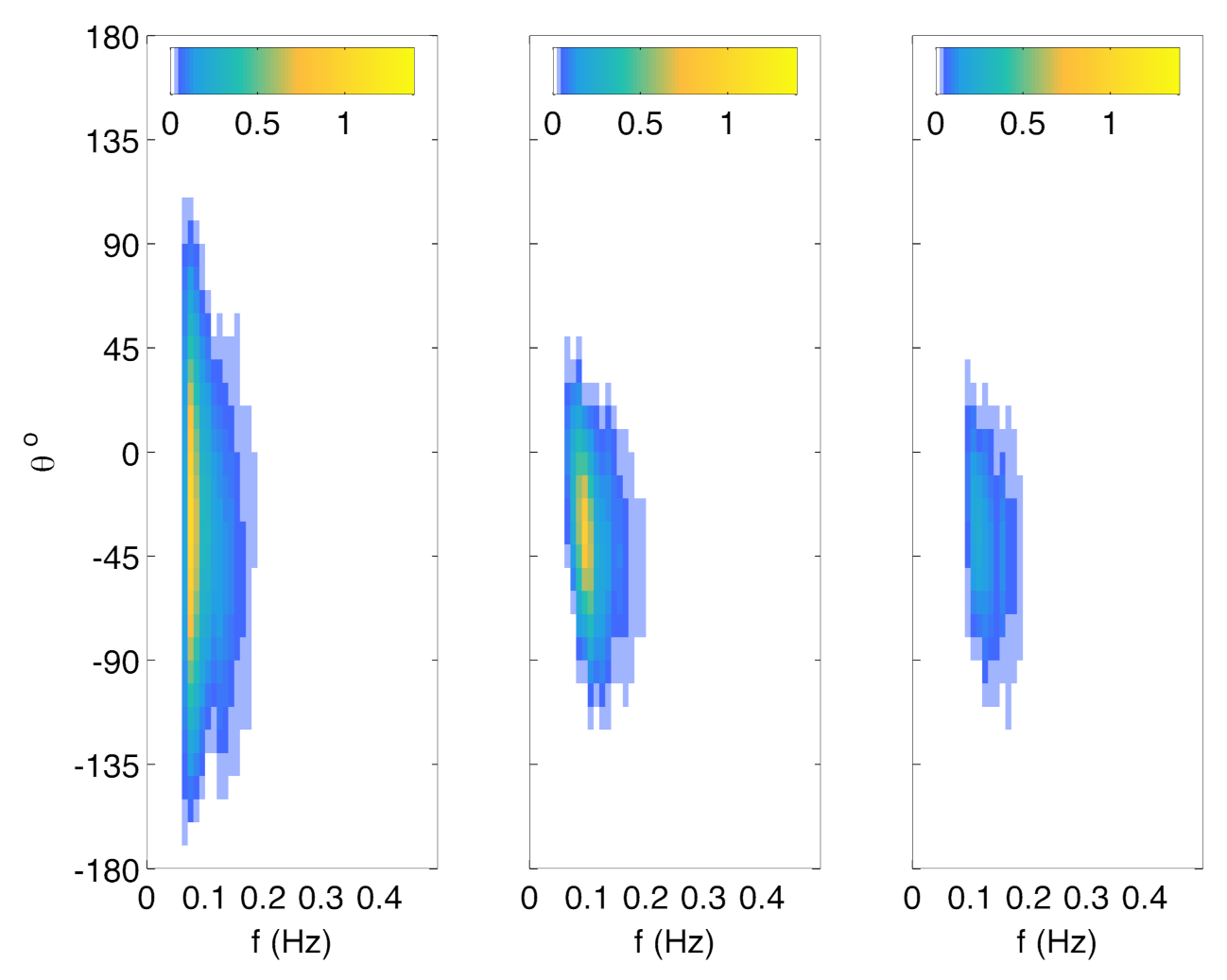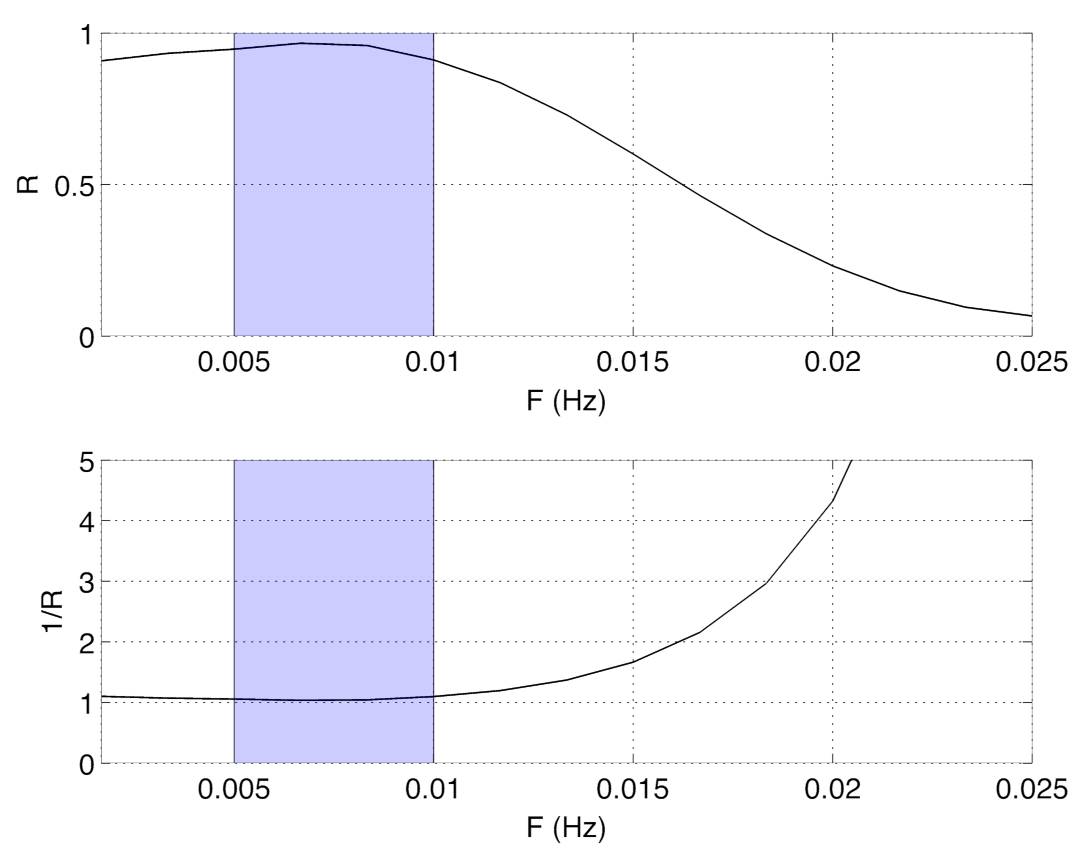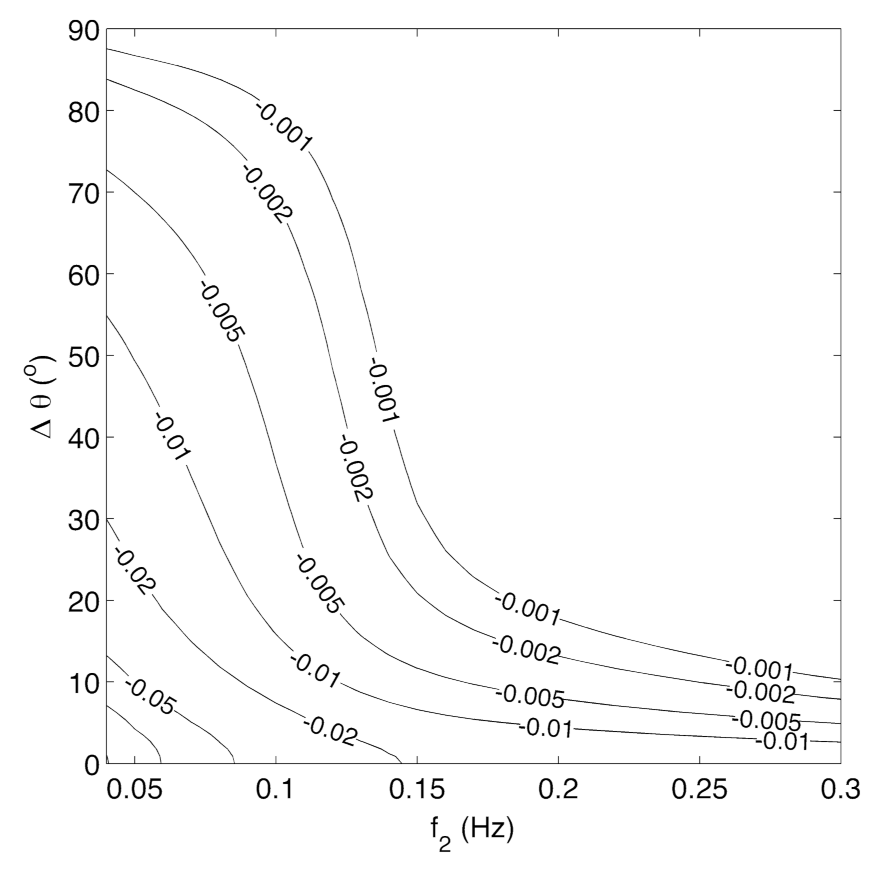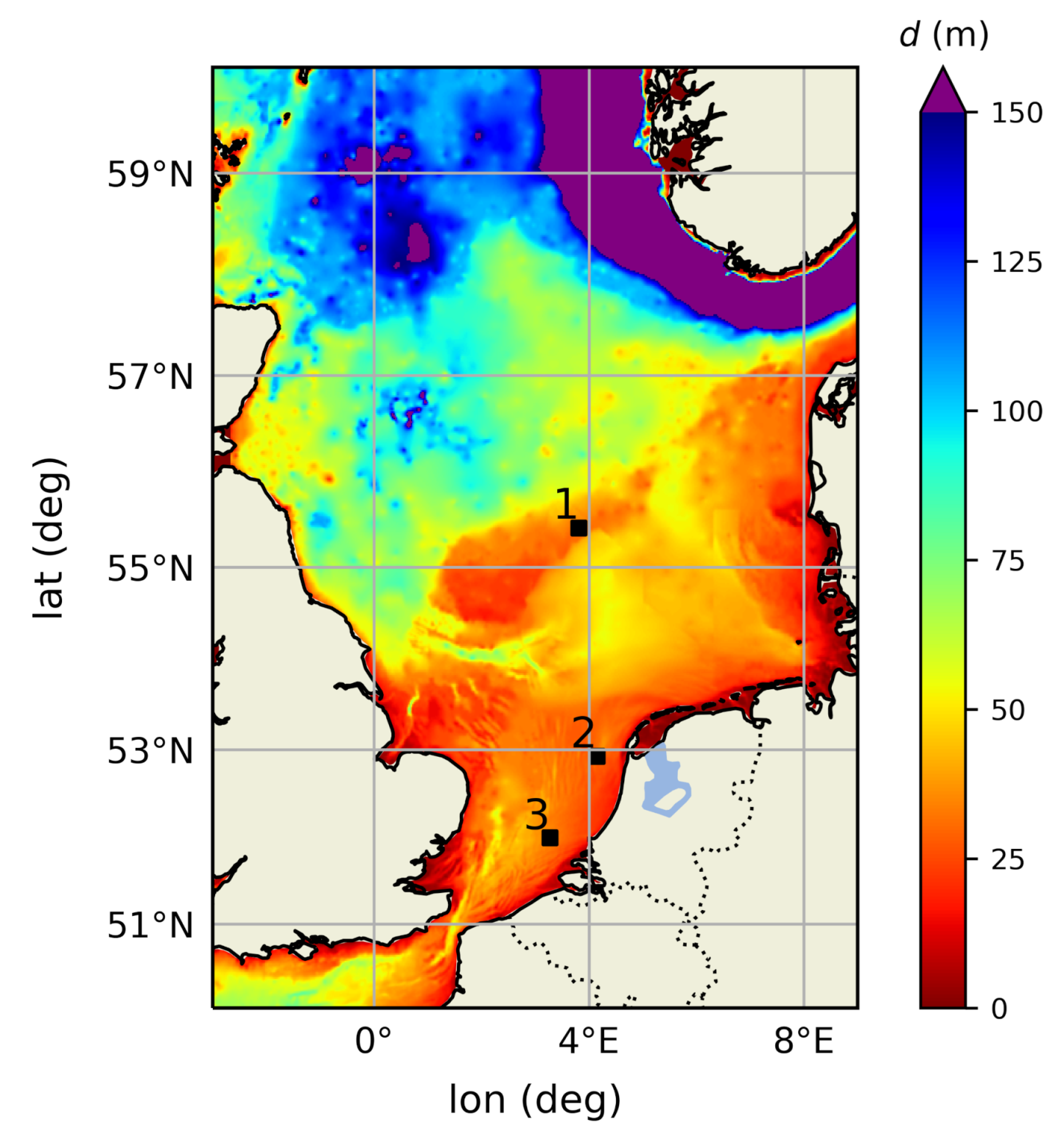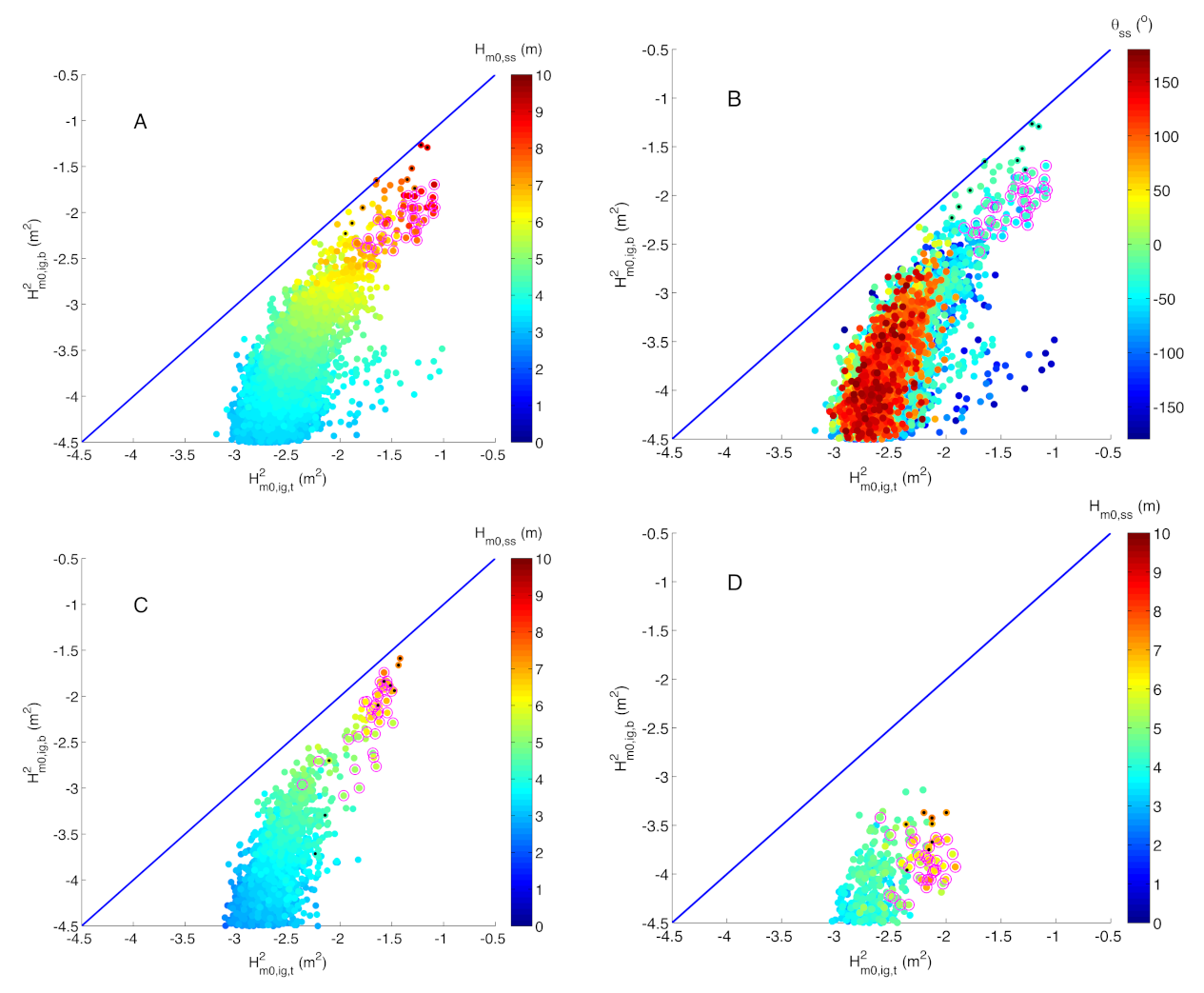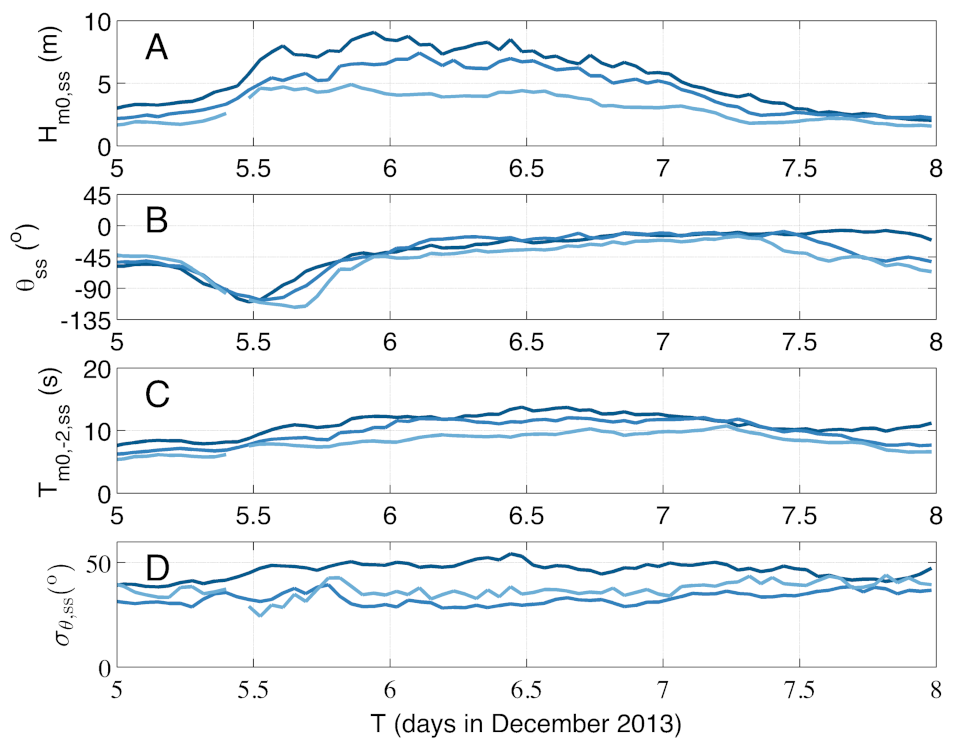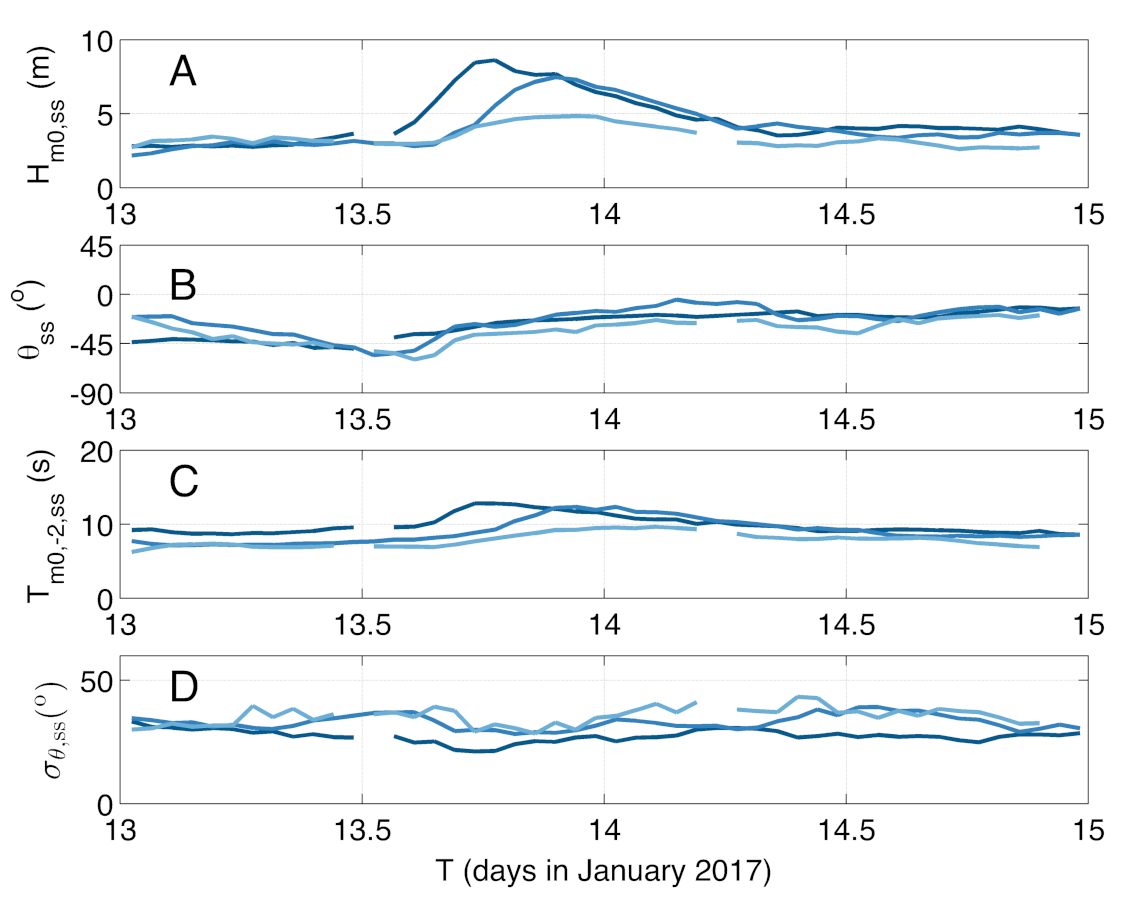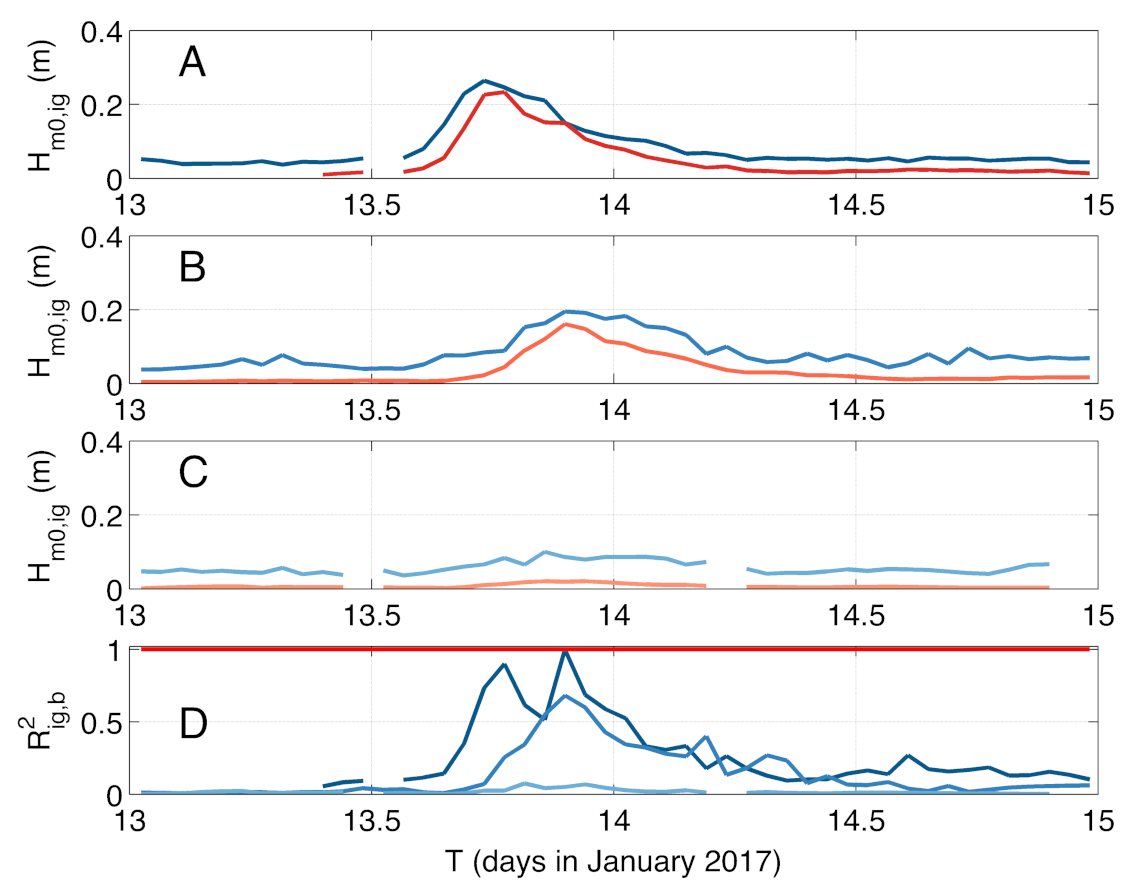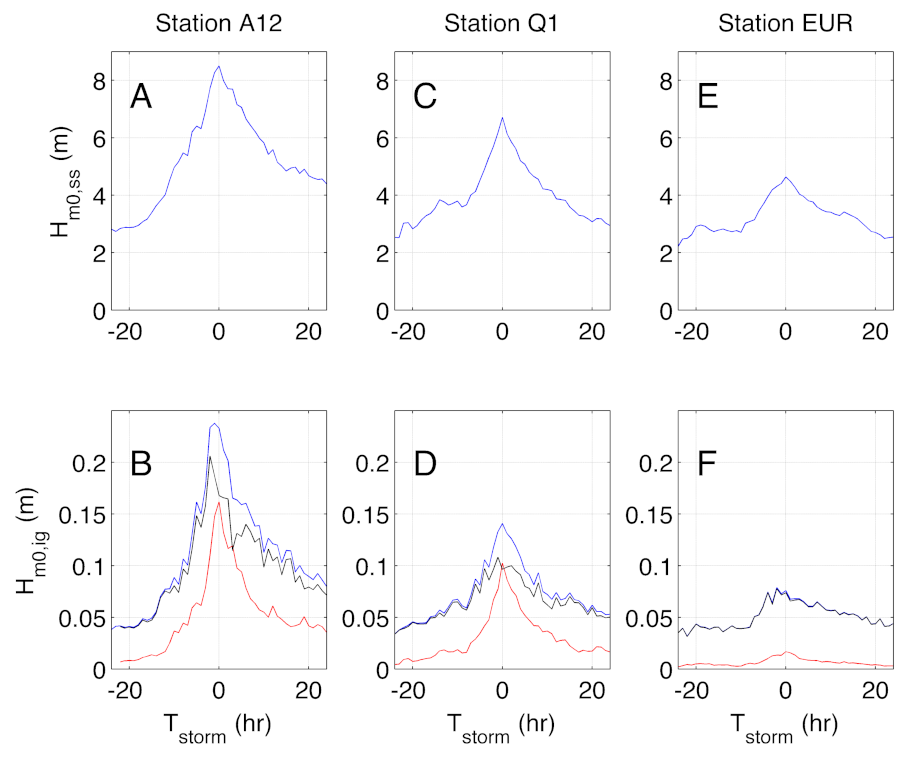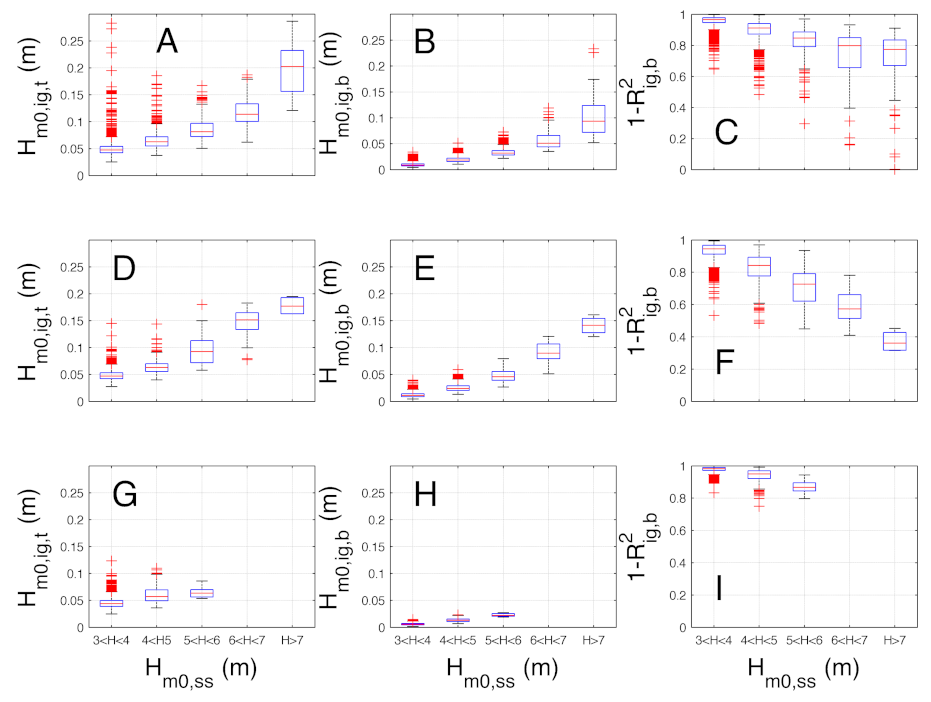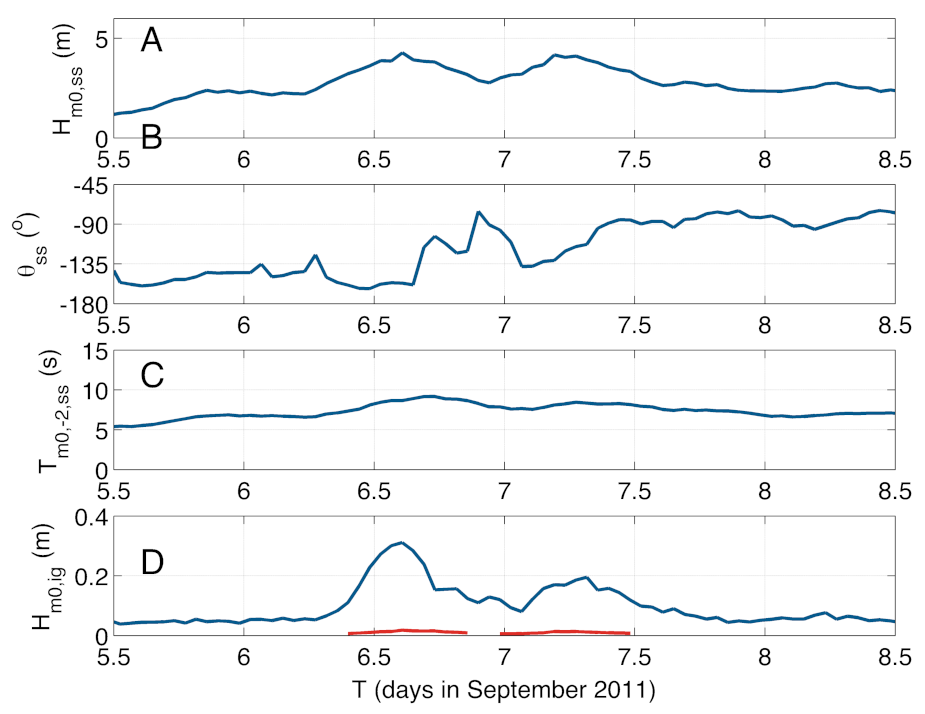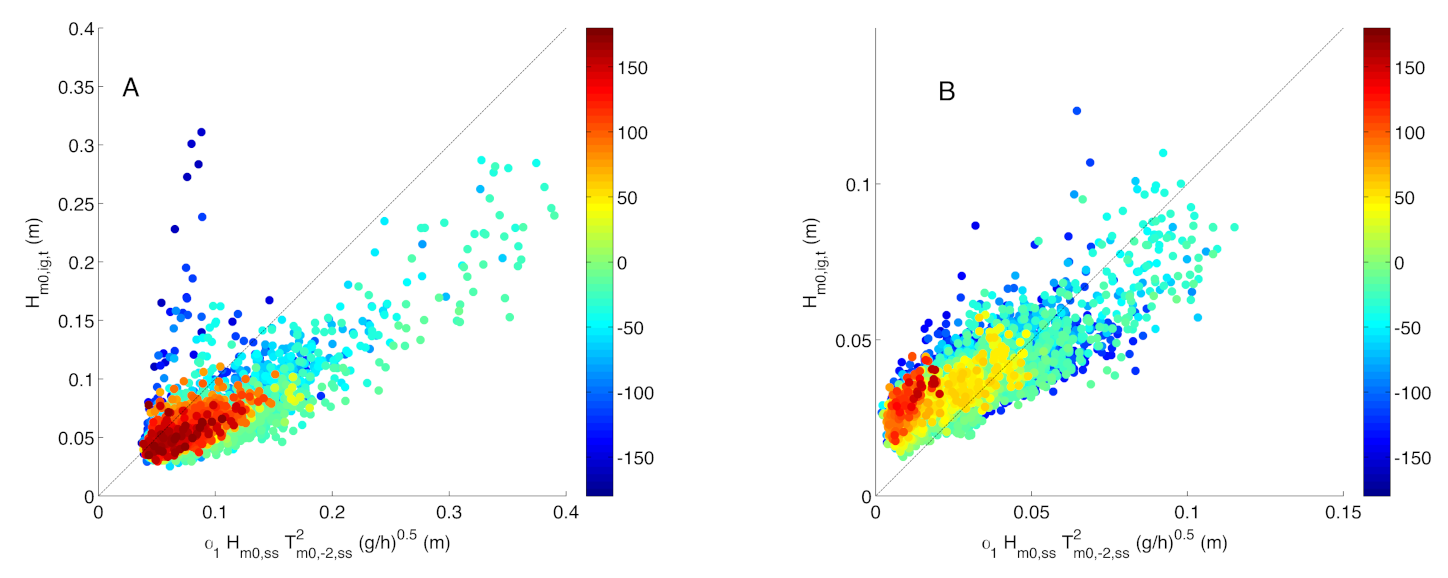1. Introduction
The interference of sea-swell waves is controlled by the frequency-directional spectrum of the incident waves resulting in wave groups with periods between approximately 25 s to 200 s. These wave groups create a modulation in the radiation stress, forcing infragravity (IG) waves that propagate with the wave groups [
1,
2]. As the sea-swell wave groups approach the beach individual short waves become gradually steeper and ultimately break and dissipate their energy in the surfzone coined surfbeat by Munk [
3]. The accompanying IG waves get subsequently released and (partially) reflect at the shoreline. On mildly sloping beaches this results in a dominance of IG wave energy at the waterline [
4], controlling the run-up and potential overtopping at the beach [
5], as well as dune erosion [
6].
Modeling the impact of incident IG waves on beaches and dikes requires an offshore boundary condition that represents the incident IG waves, i.e., directed toward the coast [
7]. This boundary condition is generally obtained by assuming a local equilibrium between the directionally-spread incident sea-swell wave forcing and the bound IG waves [
1,
8]. There are two potential problems with this approach. First, both modeling and observations have shown that the local equilibrium approach at times may significantly overestimate the sea-swell forced IG waves [
9,
10]. This is related to the fact that the transfer of energy from the sea-swell waves to the underlying IG waves on a sloping bed needs time and thus distance to occur. In case the changes in water depth and accompanying sea-swell conditions are large within an IG wave length, the equilibrium condition is not reached. Secondly, by using the local equilibrium it is implicitly assumed that only bound IG waves are incident on the coast. However, Ardhuin et al. [
11] and Rawat et al. [
12] have shown that IG waves generated at one coast can reflect and propagate across regional and even oceanic scales where they arrive as free incident IG waves at another coast. This implies that the local equilibrium approximation may in fact underestimate the incident IG energy. This contribution of the free incident IG waves to the total incident IG spectrum will depend, among other things, on the coastal configuration, where steep bathymetric slopes can trap a large part of the reflected IG energy [
13]. However, in regional seas like the North Sea where the bathymetric changes are mild, a significant part of the reflected IG energy may potentially travel from coast to coast affecting the local incident IG conditions and subsequent runup and associated coastal safety during severe storms. Hence, depending on the coastal configuration, the local equilibrium approximation may result in an overestimation or underestimation of the incident IG waves.
The overarching question is therefore whether the incident offshore IG conditions can be predicted with confidence using the observed local frequency-directional spectrum to predict the bound IG waves or that the free IG waves need to be taken into account to properly represent the incident IG waves in deeper water. The first step in this is to establish the role of free and bound IG waves during storm conditions. To that end, we explore the combined observations of IG waves and concurrent sea-swell conditions at the North Sea during the time period from 2010 to 2018. Observed IG wave periods are limited to a range between 100 s to 200 s due to experimental limitations and as such cover a subset of the full IG frequency spectrum. The data are analyzed to explore which part of the IG wave height can be contributed to bound IG waves during storm conditions at three measurement stations with similar depths but different coastal proximity to provide insight in their temporal evolution and spatial distribution. This is achieved by examining some of the more extreme storms in detail during this period combined with a statistical analysis of the decadal IG wave conditions. This is followed up with a discussion and recommendations for more comprehensive observations and modeling and conclusions.
4. Discussion
The observations show that there are significant differences in the observed total IG wave height at the different stations that cannot be explained by the differences in IG wave shoaling associated with small differences in local water depth (see
Table 1). Part of the spatial variability can be attributed to changes in the bound IG wave height response (compare panels B, E and H in
Figure 8). For the lower sea-swell wave conditions the predicted bound IG wave heights at EUR are typically smaller than at the other stations. As a result, they contribute only marginally to the total IG wave height that is similar at all stations for these moderate sea-swell wave heights. This lower IG response is consistent with the fact that the median mean sea-swell wave period at EUR is shorter than at the other stations (compare panels C with A and B in
Figure 9) and somewhat larger water depth (see
Table 1) resulting in a smaller interaction coefficient (see
Appendix C). For the higher sea-swell wave heights the bound IG wave height is largest at Q1. This in turn can be attributed to the larger median mean sea-swell period (compare panels B with A in
Figure 9) as well as the slightly smaller water depth at this location. As the median mean wave period for the bin with the highest sea-swell waves is similar at Q1 and A12, it does not explain why the median bound IG wave height is significantly larger at Q1 (compare panels B and E in
Figure 8). Furthermore, for the higher sea-swell wave heights, IG wave statistics at A12 show a persistent predominance of free IG waves that is in contrast with the observations during Egon with an approximately 100 % contribution by bound IG waves at the peak of the storm (compare panels A and D in
Figure 6 and panel C in
Figure 8). This apparent mismatch can be explained by the differences in directional spreading of the sea-swell waves where a narrow spreading is expected to lead to an increased contribution of the bound IG wave (see
Appendix C) and subsequent decreased contribution of the free IG waves [
16]. Restricting the IG cases to sea-swell cases with a directional spreading of less or equal than 30
confirms this where the median bound IG wave height at A12 has increased substantially (compare panels D, E and F with A, B and C in
Figure 8 and
Figure 9, respectively) whereas the results at Q1 are not affected (not shown).
Spatial variability in the total IG wave height will also result from changes in the free IG waves related to refraction, reflection and trapping, dissipation by bed friction and differences in the non-linear transfer and release from the sea-swell waves forcing the IG waves. This is for instance evident in the storm-averaged temporal response (see
Figure 7) exhibiting a significant increase in the total IG wave signal at the onset of the storm that is different at the three locations. The majority of this increase is related to free IG waves that are preceding the peak of the storm. Based on the observations, it is not clear whether these IG forerunners are related to the earlier release of bound IG waves due to bathymetric variability (see
Figure 1), the generation by other mechanisms like wind gusts [
17] or the arrival of reflected IG waves from nearby up-wave coasts [
11,
12]. The predominance of free IG waves trailing the peak of the storm is consistent with the reflection and trapping of IG waves in the down-wave sea-swell direction.
The bound IG estimates are based on the reconstructed frequency-directional sea-swell spectra (
Appendix A and
Appendix C). The fact that the reconstruction only allows for uni-modal directional distributions may result in inaccurate estimations, especially at times of broad directional spreading. As the time-series of the sea-swell surface elevation are not available, this potential error in the estimated bound portion of the IG waves cannot be verified with a bi-spectral analysis [
18] and hence it is not known how well the predicted bound IG wave heights correspond to the observations under these conditions.
It is noted that by excluding the spectra with a broad directional spreading, the outliers for the lower sea-swell wave height bins have been removed (compare left panel of
Figure 9 with panel A in
Figure 8 for
m). The bulk of these outliers are associated with a single event in September of 2011 and are only present at A12 (see
Figure 10). At that time, the sea-swell waves are incident from the southerly direction with a moderate storm wave height of
m and wave period of less than 10 s. As expected, this results in a minimal contribution of the bound IG variance to the observed total IG variance (see panel D in
Figure 10). There is no indication that the observations are erroneous and as such may be related to the resonant transfer from the spatially varying wind forcing or air pressure fluctuations that are known to occur within the southern part of the North Sea [
19].
The offshore boundary condition for IG storm impact computations requires the incident part of the IG waves, i.e., the onshore directed components. However, the directional information on the IG energy propagation is missing as the measurements consider the surface elevation only and thus a separation of the incident and reflected IG wave components is not possible at this time. However, combining the current observations with numerical modeling can shed light on the directional properties of the IG waves as well. One promising approach is the use of a backward ray-tracing method to examine the wave rays of the free IG waves radiating away from the coast showing the potential effects of refractive trapping (e.g., [
13]). Alternatively, the approach outlined by Ardhuin et al. [
11] can be used to examine the refractive trapping and leakage of the reflected IG waves with a spectral wave model. In that case, a directionally isotropic IG source along the coast is imposed as a boundary condition with an intensity that is based on a parametric expression involving the incident sea-swell wave height, period and local water depth:
where
g is the gravitational acceleration,
h is the local water depth and
is a spatially dependent constant.
Ardhuin et al. [
11] found a near linear dependence between the IG wave height and
at different measuring stations with a mean value of
s
. Examining this relationship for the three stations shows that using a constant value for
is not representative for all incident sea-swell wave directions. At A12, the earlier mentioned anomalous response for sea-swell waves from the southerly directions is clearly visible (see blue dots in Panel A of
Figure 11). The IG response for the other directions is more or less constant. This is different from the IG response at both Q1 (not shown) and EUR (panel B of
Figure 11), where waves incident from the easterly directions create a relatively stronger response in the IG wave height compared to sea-swell waves incident from the westerly directions. This is to be expected if the beach characteristics, most notably the beach slope, are different at the coast where free IG waves are reflected from. By examining the IG response for different storms it should be possible to obtain spatially dependent estimates of the
scaling factor. These modeling efforts should ideally be supported with additional field observations of co-located velocity and surface elevation or pressure measurements to compare with the model predicted directional properties of the IG waves and more specifically the incident free IG component.
The IG waves discussed here have been observed in water depths between 28 m and 34 m (see
Table 1) and are expected to increase substantially between these depths and the nearshore. In the case of free IG waves, this transformation is similar to the incident sea-swell waves where refraction and shoaling are important [
11]. For the bound IG waves this is controlled by the non-linear interaction with the sea-swell waves, which depends strongly on the frequency-directional distribution of the latter as well as the beach slope [
9,
10]. The relative importance of these processes will determine the potential storm impact of the free IG waves and bound IG waves at the coast.
